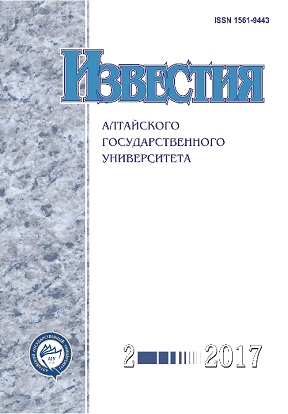The Organization of Forests Management in the Altai and Tomsk Provinces during Short-Term Establishment of the Soviet Power in the First Half of 1918
Abstract
The article considers the process of formation of administrative structures and realization of the new principles of management of land forestry on the territory of the Altai and Tomsk provinces in the first half of 1918. The formation of administrative structures occurred in parallel with the abolition of the former system of management of state property. The Soviet state forest policy was based on several principals: nationalization of natural resources, obligatory participation of the population in forest conservation, joint management of the former state-owned land and forest property, the greatest possible exploitation of the woods, even to the detriment of interests of rational forestry. The first steps of the new government on the formation of the Soviet administrative apparatus caused the rejection, not only from political opponents of the Bolsheviks and forest employees, but a considerable part of the population. After coming to power of the Provisional Siberian government all transformations in the sphere of forest management, made by the Soviet regime were abolished and the former control system of the state forest property was restored.
DOI 10.14258/izvasu(2017)2-25
Downloads
Metrics
References
Государственный архив Алтайского края (ГААК). - Ф. 233. - Оп. 3. - Д. 12.
Собрание узаконений и распоряжений правительства за 1917-1918 гг. - М., 1942.
Лебедев И.В. Лесная политика советского государства: исторический опыт и проблемы : дис. … канд. ист. наук. - М., 1992.
Государственный архив Томской области (ГАТО). - Ф. 240. - Оп. 1. - Д. 15.
Деятельность государства по охране лесов в 1917-1929 гг.: сборник документов / сост. и вступ. статья М.О. Тяпкин. - Барнаул, 2017.
ГААК. - Ф. 73. - Оп. 1. - Д. 17.
ГААК. - Ф. 4. - Оп. 1. - Д. 555.
ГААК. - Ф. 233. - Оп. 5. - Д. 16.
ГАТО. - Ф. 241. - Оп. 1. - Д. 123.
Дробченко В.А. Органы местного самоуправления в Томской губернии в период Гражданской войны (1918 1919 гг.) // Вестник Кемеровского государственного университета. - 2015. - №2-6 (62).
ГААК. - Ф. 73. - Оп. 2. - Д. 10.
Поляков С.Е. Реорганизация системы управления Алтайским округом в период временного установления советской власти (декабрь 1917 г. - июнь 1918 г.) // Исторический опыт хозяйственного и культурного освоения Западной Сибири : Четвертые научные чтения памяти проф. А.П. Бородавкина: сборник научных трудов. - Барнаул, 2003. - Кн. II.
ГААК. - Ф. 73. - Оп. 1. - Д. 17а.
ГААК. - Ф. 4. - Оп. 1. - Д. 561.
ГААК. - Ф. 4. - Оп. 1. - Д. 555.
Izvestiya of Altai State University is a golden publisher, as we allow self-archiving, but most importantly we are fully transparent about your rights.
Authors may present and discuss their findings ahead of publication: at biological or scientific conferences, on preprint servers, in public databases, and in blogs, wikis, tweets, and other informal communication channels.
Izvestiya of Altai State University allows authors to deposit manuscripts (currently under review or those for intended submission to Izvestiya of Altai State University) in non-commercial, pre-print servers such as ArXiv.
Authors who publish with this journal agree to the following terms:
- Authors retain copyright and grant the journal right of first publication with the work simultaneously licensed under a Creative Commons Attribution License (CC BY 4.0) that allows others to share the work with an acknowledgement of the work's authorship and initial publication in this journal.
- Authors are able to enter into separate, additional contractual arrangements for the non-exclusive distribution of the journal's published version of the work (e.g., post it to an institutional repository or publish it in a book), with an acknowledgement of its initial publication in this journal.
- Authors are permitted and encouraged to post their work online (e.g., in institutional repositories or on their website) prior to and during the submission process, as it can lead to productive exchanges, as well as earlier and greater citation of published work (See The Effect of Open Access).








